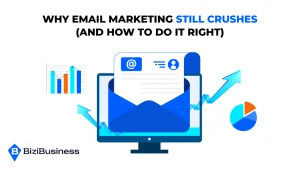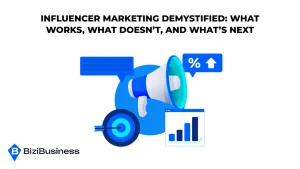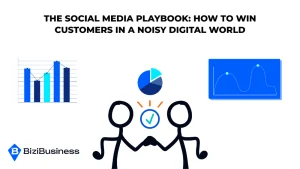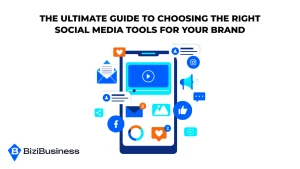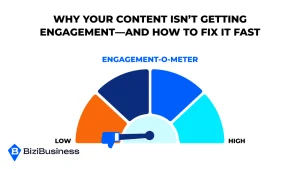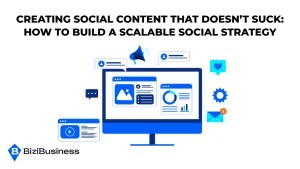BiziTopics
Email Deliverability Explained: How to Boost Reach, Reputation And ROI
BiziBusiness
Aug 12, 2025
17 min read
You can write the perfect email—but if it lands in spam, none of it matters.
Email deliverability determines whether your message reaches the inbox. It’s one of the most overlooked drivers of ROI in email marketing—and one of the biggest reasons open rates crash without warning.
This guide breaks down how deliverability works, how to spot issues, and how to fix them—so your emails actually get seen, clicked, and converted.
Because great emails don’t just need to be written. They need to be delivered.
What Is Email Deliverability (And What It’s Not)
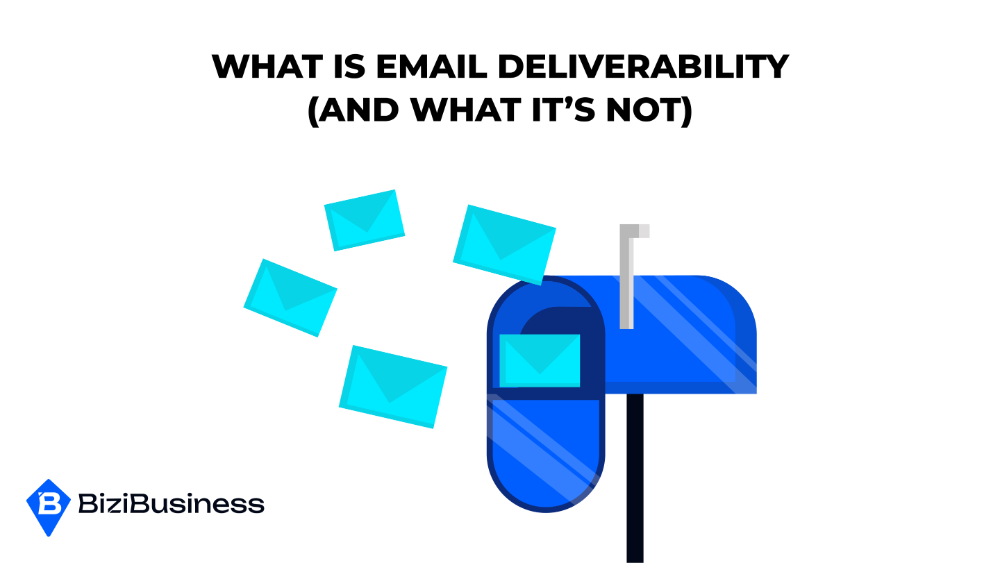
Email deliverability is the ability of your emails to reach the inbox, not just the recipient’s email server. Just because your email is marked “delivered” doesn’t mean it wasn’t filtered into spam or junk.
Here’s the difference:
- Delivery = The email was accepted by the server
- Deliverability = The email landed where it was supposed to—in the inbox
Internet Service Providers (like Gmail, Outlook, Yahoo) decide inbox placement based on a mix of sender reputation, authentication, content quality, and subscriber engagement.
If your open rates are falling, spam complaints are rising, or your emails just don’t seem to get traction—deliverability is likely the culprit.
Key metrics that help measure it:
- Inbox placement rate
- Bounce rate (soft and hard)
- Spam complaint rate
- Sender score and domain reputation
Understanding deliverability means looking past “sent” and focusing on “seen.”
The Core Factors That Influence Deliverability
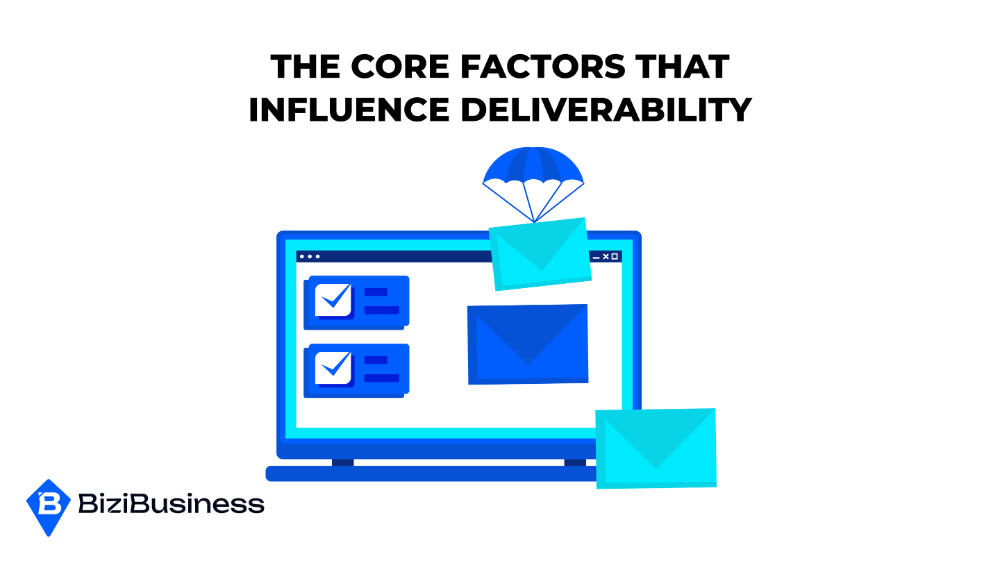
Email deliverability isn’t random—it’s the result of multiple signals that inbox providers monitor constantly. If even one of these areas is weak, your emails may quietly slip into spam or fail to be delivered at all.
Below are the five core pillars that determine whether your emails reach the inbox—or disappear before they’re seen.
1. Sender Reputation: Your Digital Trust Score
Just like a credit score, sender reputation is built over time and can be damaged in an instant. It’s based on how email providers perceive your sending behavior, list quality, and recipient response.
What influences sender reputation:
- Spam complaint rates (users marking your emails as spam)
- Bounce rates from invalid or expired email addresses
- How many people open, click, or reply to your emails
- Your consistency—large, erratic spikes in send volume raise red flags
Why it matters: A strong sender reputation increases your chance of hitting the inbox. A poor one will get you throttled, filtered, or blocked entirely.
2. Authentication Protocols: Proving You’re Legit
Email authentication is like showing your ID at the door. It verifies that your messages come from a trusted, authorized source—not a spammer or impersonator.
The four key protocols:
- SPF (Sender Policy Framework): Confirms your domain allows the sending IP
- DKIM (DomainKeys Identified Mail): Validates your message hasn’t been tampered with
- DMARC (Domain-based Message Authentication): Tells inbox providers what to do if SPF or DKIM fails
- BIMI (Brand Indicators for Message Identification): Allows your brand logo to appear in the inbox (optional but valuable)
Why it matters: Without proper authentication, your messages are far more likely to be rejected, flagged as phishing, or dumped into spam.
3. Content Quality: What You Say and How You Say It
Spam filters don’t just scan for malicious intent—they look for low-quality, “spammy” messaging too. Your copy, formatting, and even your subject line can trigger filters.
Watch out for:
- Trigger words like “BUY NOW,” “100% FREE,” or “GUARANTEED INCOME”
- Poor formatting (e.g., ALL CAPS, excessive punctuation, broken HTML)
- Too many images, not enough text (or vice versa)
- Broken links or misleading CTAs
Why it matters: If your emails look suspicious—even unintentionally—they’ll be filtered, not opened.
4. List Quality and Hygiene: Who You’re Sending To
Even the best emails won’t save a dirty list building. Deliverability is directly tied to the quality of your contacts—whether they’re engaged, valid, and opted-in.
Hygiene best practices:
- Use double opt-in to confirm subscriptions
- Regularly remove unengaged or bounced contacts
- Never buy, rent, or scrape email lists
- Monitor engagement and segment accordingly
Why it matters: High bounce rates and disengaged contacts tell inbox providers your list isn’t trustworthy—which hurts everyone else you’re trying to reach.
5. Sending Behavior: The Rhythm That Builds Trust
Sending too much, too little, or too unpredictably can hurt deliverability. ISPs prefer senders who maintain a healthy, consistent rhythm and engage with active audiences.
Smart sending behavior:
- Start small and warm up gradually, especially on new domains
- Keep a consistent schedule (weekly, biweekly, etc.)
- Segment based on engagement (don’t blast everyone all the time)
- Avoid large spikes in volume without a warmup plan
Why it matters: Trust is built over time. Sporadic, aggressive, or inconsistent sending can trigger throttling or spam flags—even if your content is solid.
When these five elements work together—trustworthy sender reputation, authenticated messages, high-quality content, clean lists, and smart sending behavior—you don’t just land in inboxes.
You stay there.
How To Diagnose A Deliverability Problem

If your open rates are tanking, your revenue from email campaigns is dropping, or engagement seems off—you might have a deliverability issue. But because inbox placement isn’t always visible, most marketers don’t know how to spot the signs.
Here’s how to tell if deliverability—not content or timing—is the real problem.
1. Look for These Red Flags
Some warning signs are subtle. Others scream for attention. If you notice any of the following, it’s time to investigate:
- Sudden drop in open rates across multiple campaigns (not just one subject line)
- High bounce rates, especially soft bounces (temporary delivery issues)
- Consistent decline in click-throughs, even with strong offers
- An uptick in unsubscribes or spam complaints
- Your emails are consistently landing in spam or promotions tabs (test with personal inboxes)
2. Test Inbox Placement Across Providers
Don’t rely on open rate alone. Your campaign may be hitting Gmail but not Outlook, or vice versa.
Tools to help:
- Seed testing services (e.g., GlockApps, Mailtrap, Mail-Tester)
- Gmail’s Postmaster Tools – shows IP/domain health, complaint rates, and spam signals
- Microsoft SNDS (Smart Network Data Services) – for Outlook/Hotmail sender reputation
- Deliverability monitoring from your ESP (if supported)
These tools simulate inbox placement across providers so you can see if you’re landing in spam or inbox—and where the breakdown is happening.
3. Check Your Domain and IP Reputation
Your domain and IP are like your digital sender ID. If they’re flagged as untrustworthy, your emails won’t make it through.
Where to check:
- Sender Score (Validity): Grades your IP’s trustworthiness on a scale of 0–100
- Talos Intelligence (Cisco): See if your IP/domain is listed as a threat
- MXToolbox: Checks for DNS issues, blacklist status, and more
- Google Postmaster Tools: Tracks reputation over time (Gmail-specific)
If your score is low or you’re on a blacklist, that’s a deliverability emergency.
4. Review Your Sending Patterns
Look for changes in volume or audience targeting that may have triggered filters:
- Did you recently email design your full list for the first time in months?
- Have you added a large number of new contacts without validating them?
- Have you changed your “From” domain or sending IP?
Even positive actions—like switching email platforms—can damage deliverability if you don’t warm up correctly.
5. Compare Trends, Not Just Campaigns
Deliverability problems usually show up over time. Pull 30–90 days of data to review:
- Open rate averages by domain (Gmail vs. Outlook vs. Yahoo)
- Engagement trends across segments (new vs. existing subscribers)
- Complaint and bounce trends by send time or segment
This broader view helps distinguish deliverability issues from content performance issues.
How To Fix (And Improve) Email Deliverability
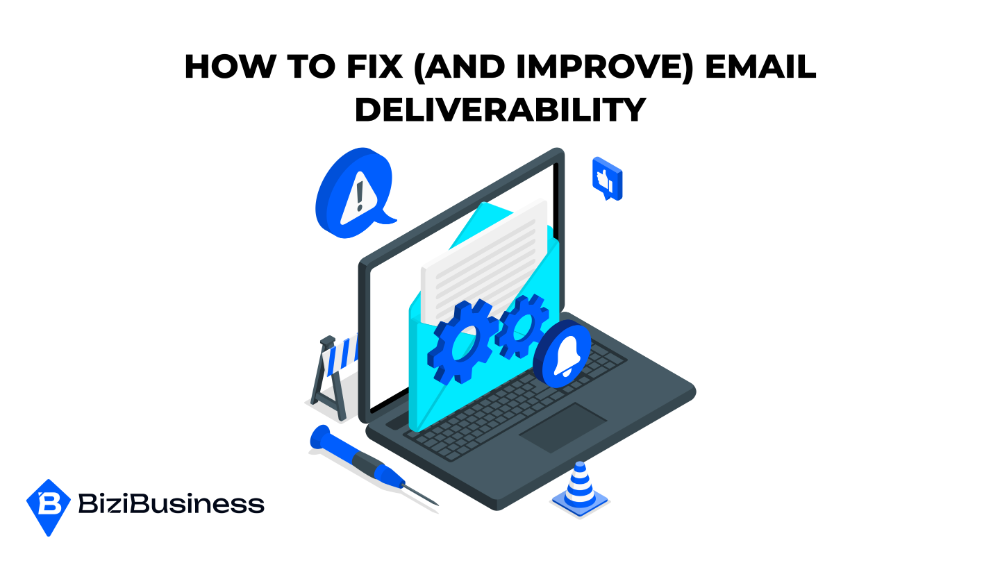
If you’ve confirmed a deliverability issue—or want to future-proof your inbox placement—the solution isn’t just one fix. It’s a combination of technical adjustments, behavior changes, and smarter audience management.
Here’s a comprehensive, step-by-step guide to both repairing and strengthening your deliverability.
1. Warm Up Your Domain and IP Gradually
When you start sending from a new domain or switch to a new IP address, inbox providers don’t trust you yet. Sudden high-volume sends from an unknown sender often trigger spam filters.
How to warm up properly:
- Start by emailing only your most engaged subscribers (recent openers and clickers)
- Send in small, steady batches—gradually increasing daily volume over 2–3 weeks
- Maintain consistent sending patterns (time, frequency, and cadence)
- Monitor open and click rates during the warmup period to catch early issues
Why it matters: This builds your sending reputation slowly and signals to providers that you’re a reliable sender—not a spammer.
2. Segment Based on Engagement to Protect Reputation
One of the biggest deliverability killers is sending to large lists full of inactive users. When recipients don’t open, click, or interact, inbox providers assume your messages aren’t wanted—and filter them accordingly.
What to do:
- Build engagement tiers (e.g., 0–30, 31–60, 61–90 days since last open)
- Send more frequently to highly engaged segments
- Gradually reduce sends to cold segments or pause them entirely
- Use re-engagement campaigns with clear subject lines, personalization, and a reason to respond
Why it matters: Engagement signals are one of the most heavily weighted deliverability factors. Inbox providers watch how people interact with your emails—and disengagement looks like spam.
3. Use Confirmed Opt-In and Regular List Cleaning
Not all email addresses on your list are valid or safe. Over time, even clean lists degrade. Bots, typos, and old domains can all increase bounce rates and reduce inbox trust.
Best practices:
- Use double opt-in (confirmed opt-in) to ensure real people are subscribing
- Regularly remove:
- Hard bounces (invalid addresses)
- Contacts inactive for 6+ months (unless successfully re-engaged)
- Spam complainers or unsubscribes
- Use email verification tools like NeverBounce, ZeroBounce, or Emailable to scan lists before large campaigns or imports
Why it matters: High bounce rates and unengaged recipients tell inbox providers you’re sending to bad data—which damages sender reputation and affects future campaigns.
4. Optimize Content to Avoid Spam Filters
Even if your tech setup is perfect, bad email content can trigger filters and tank inbox placement.
Key optimization tips:
- Avoid spammy subject lines (“Act Now!”, “You’re Approved!”, “100% Free!”)
- Limit use of CAPS, emojis, and excessive punctuation (!!!)
- Maintain a balanced image-to-text ratio (don’t send a single giant image)
- Ensure all links are clean, relevant, and go to reputable domains
- Always include a working unsubscribe link and sender address
- Add alt text to images and format for mobile responsiveness
- Send plain text versions alongside HTML emails (many filters expect this)
Why it matters: Spam filters scan emails just like anti-virus software—if your content resembles phishing, junk, or promotional overload, you’ll get flagged fast.
5. Monitor Your Reputation and Deliverability Regularly
Don’t wait for a crash to investigate. Proactive monitoring gives you early warnings and insight into how inbox providers view your sending habits.
What to monitor and where:
- IP & domain reputation:
- Sender Score (Validity)
- Talos Intelligence (Cisco)
- Google Postmaster Tools
- Microsoft SNDS
- Blacklist status & DNS health:
- MXToolbox
- DNSstuff
Why it matters: Just one blacklist or low reputation score can cut your deliverability in half—without you realizing it.
6. Maintain Consistent Sending Habits
Erratic sending patterns are a red flag to inbox providers. Sending nothing for weeks, then launching a massive campaign, looks suspicious.
What to do:
- Establish a consistent send cadence (weekly, biweekly, etc.)
- Avoid sudden spikes in send volume—especially to cold audiences
- Match your send times to engagement patterns
- Send during business hours and test timing for different time zones
Why it matters: Reliability breeds trust. Inbox providers reward consistent, healthy senders with better placement—and punish erratic senders with spam filtering or delivery delays.
Building A Deliverability-First Email Strategy
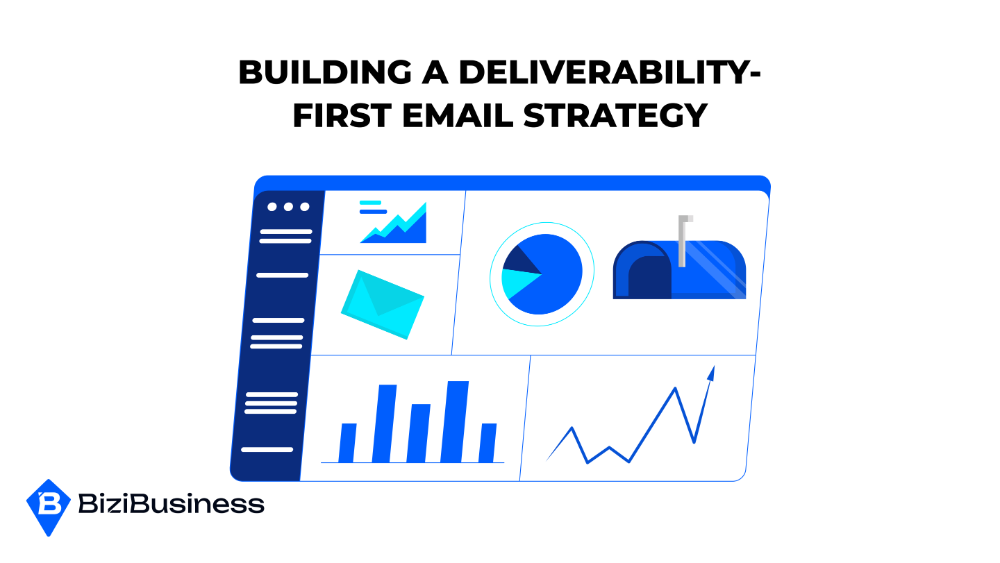
Great deliverability isn’t just the result of a one-time fix—it’s the byproduct of consistent, intentional habits built into your entire email marketing approach. Brands that consistently reach the inbox do so because they embed deliverability into their strategy and planning not because they scramble when problems arise.
Here’s how to build a marketing system that treats inbox placement as a permanent priority.
1. Prioritize Engagement Over Volume
The best deliverability signal you can send? Engagement. Inbox providers like Gmail and Outlook track how recipients interact with your emails—and adjust inbox placement accordingly. A list of 10,000 active, engaged subscribers will outperform a bloated list of 100,000 dormant ones every time.
How to do it:
- Segment by behavior, such as opens, clicks, or site visits, and tailor campaigns by activity
- Send fewer, more relevant emails, especially to cold or low-engagement segments
- Build dynamic automations that respond to user actions (like purchases or downloads) instead of pushing a fixed send calendar
- Ask subscribers for preferences (frequency, content type) to maintain interest over time
Why it matters: Every unengaged subscriber weakens your sender reputation. Prioritizing engagement strengthens it—and gives you better insights into what your audience wants.
2. Automate List Hygiene to Keep Data Fresh
Dirty lists degrade over time—and they’re one of the top causes of deliverability failure. Yet most marketers only clean lists during migrations or after a deliverability drop. By making hygiene automatic, you reduce bounces and complaints before they become a problem.
How to build this into your process:
- Set up automated filters to remove invalid emails (bounces, typos)
- Create a re-engagement automations & workflows that triggers after 60–90 days of inactivity
- Use tagging to isolate inactive users, then suppress or sunset them after 120–180 days if they don’t respond
- Use list validation tools monthly or quarterly to catch outdated or dangerous addresses (especially if you’re collecting leads from multiple sources)
Why it matters: Hygiene isn’t glamorous—but it’s one of the most cost-effective ways to protect your sender reputation and improve inbox placement.
3. Add Deliverability Metrics to Your Performance Reports
Most marketers report on opens, clicks, and conversions. But if you’re not monitoring how many emails actually made it to the inbox, you’re missing the full picture.
Build a deliverability layer into your reporting stack:
- Track bounce rates, especially soft bounces that hint at volume or reputation issues
- Monitor spam complaint rates, even small increases can impact entire campaigns
- Use tools like GlockApps or Postmaster Tools to check inbox placement across providers
- Evaluate engagement by domain (e.g., Gmail vs. Outlook vs. Yahoo)—a dip on one domain could signal a filtering issue
- Periodically check blacklist status and sender reputation via tools like Talos, MXToolbox, and Validity
Why it matters: You can’t optimize what you don’t measure. Deliverability analytics and metrics tell you whether your marketing is actually reaching people.
4. Create Cross-Team Standards for Sending Practices
Your email ecosystem often extends beyond marketing. Sales, support, and even billing departments may send emails through CRMs, helpdesk tools and platforms. Without shared standards, one misconfigured system—or an aggressive sender—can damage your entire domain’s reputation.
How to align your teams:
- Ensure all tools use authenticated sending (SPF, DKIM, DMARC)
- Use subdomains for transactional or third-party emails to isolate risk
- Share sending calendars across departments to avoid email fatigue
- Establish brand tone and compliance standards across all email types
- Monitor your full sending footprint (including automated and triggered emails) for inconsistencies
Why it matters: Deliverability risk is shared. A support system sending too many alerts or a cold outreach campaign from Sales can hurt your marketing campaigns—even if they’re flawless.
5. Treat Deliverability as a Long-Term Growth Lever
Email is one of the most cost-effective and scalable marketing channels. But it only works if it lands in the inbox. By treating deliverability as a strategic asset, you protect and amplify every other email investment—from content creation to automation to segmentation.
Long-term benefits of a deliverability-first mindset:
- Stronger ROI: More messages seen = more opportunities to convert
- Scalable campaigns: No fear of volume caps or filtering penalties
- Faster execution: Less time troubleshooting = more time optimizing
- Better customer experience: Fewer missed messages, duplicate sends, or frustrations
Why it matters: Great deliverability compounds. It allows you to reach more people, more reliably, with less cost over time. That’s growth—and that’s good business.
Advanced Tips For High-Volume Senders
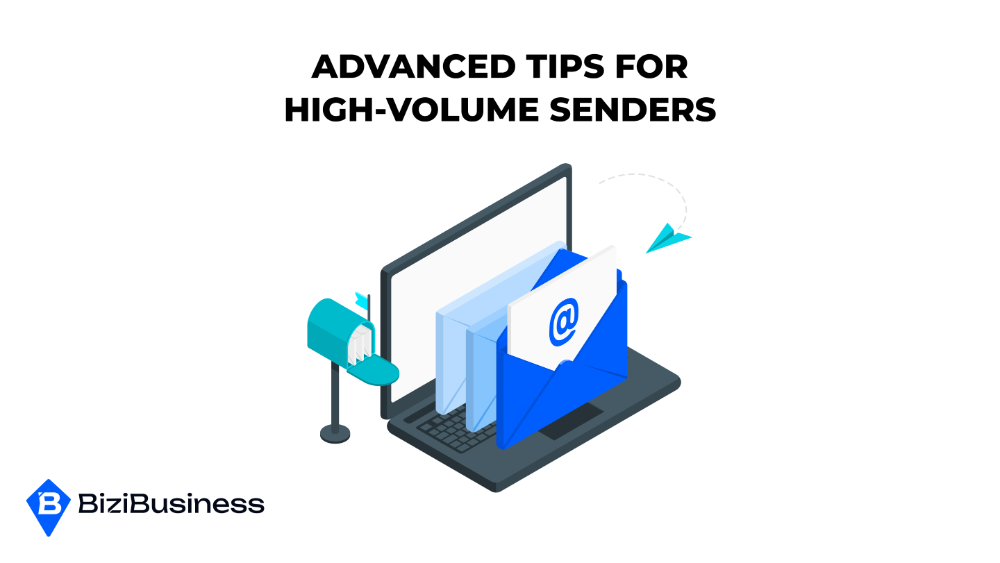
When you’re sending tens or hundreds of thousands of emails a week, small issues scale fast. At this level, inbox placement isn’t just about hygiene—it’s about infrastructure, consistency, and rigorous control over your systems.
If you manage a high-volume email program, these advanced deliverability practices will help you scale without sacrificing performance.
1. Use a Dedicated IP Address (or Pool)
Shared IPs are convenient for smaller senders—but when you’re sending at scale, your reputation should be yours alone.
Why switch to a dedicated IP:
- Full control over sender reputation
- No risk of being penalized for another sender’s behavior
- Essential for large or regulated campaigns (e.g., financial, healthcare, compliance-heavy sectors)
Pro tip: Warm up your dedicated IP gradually, just like a new domain, starting with your most engaged audience.
2. Implement Subdomain Sending Strategy
Split your sending domains by function to reduce risk and improve clarity across systems. For example:
news.brand.com→ promotional campaignstransact.brand.com→ receipts, invoices, confirmationsevents.brand.com→ webinars, invitations, announcements
Benefits:
- Isolates performance and reputation by message type
- Prevents a promotional issue from impacting critical system emails
- Gives clearer signals to inbox providers about content type
3. Maintain Domain Alignment (SPF, DKIM, DMARC)
Inbox providers evaluate not just authentication—but alignment across all domains in your email header.
Advanced practices:
- Ensure the “From” domain, return-path domain, and DKIM signing domain all match or align
- Publish and monitor DMARC reports to see who is sending on your behalf
- Set up BIMI (Brand Indicators for Message Identification) to show your logo in the inbox and signal trust
Why it matters: Aligned, authenticated domains are more trusted—especially at scale.
4. Monitor Deliverability by ISP and Campaign
At high volume, problems often affect one provider more than others. For example, Gmail may filter your messages while Outlook continues to inbox them.
Track performance by:
- Domain-level metrics (open/click rates per ISP)
- Complaint and bounce rates per domain
- Inbox placement using seed testing and optimization like 250ok, GlockApps, or Mailtrap
What to watch: A sudden drop in Gmail opens, but not Yahoo or Outlook, may indicate an ISP-specific issue—possibly a reputation hit or trigger on content.
5. Control Your Send Cadence and Throttling
High-volume sends can trigger rate limits if you push too many emails too quickly—especially to domains like Gmail or corporate inboxes.
Best practices:
- Throttle sends over 1–4 hours when delivering to large segments
- Use your ESP’s send time optimization tools if available
- Spread multi-segment campaigns across time zones and days to reduce strain
- Monitor send latency and queue time to avoid delays
Why it matters: Inbox providers are watching for volume spikes that look like spam attacks. Controlled, strategic delivery builds trust.
6. Run Deliverability Audits Quarterly
The bigger your operation, the more places things can go wrong—especially as new campaigns, tools, or teammates come online.
Audit regularly:
- DNS settings and authentication protocols
- List engagement breakdown and suppression rules
- IP/domain reputation and blacklist status
- Overlap in campaign scheduling or audience targeting
- Compliance with privacy regulations (GDPR, CAN-SPAM, CASL)
Use a checklist and delegate ownership if multiple teams or departments are sending on your behalf.
Deliverability Is the Foundation of Email Success
Email marketing remains one of the most cost-effective channels for driving engagement, conversions, and long-term customer value. But none of that matters if your emails aren’t being seen.
Deliverability is the gatekeeper—determining whether your campaigns land in the inbox or get silently filtered into spam. It’s not just a technical checkbox; it’s a strategic pillar that touches every part of your program: from acquisition and engagement to revenue and retention.
As we’ve explored in this guide, improving deliverability means:
- Building and maintaining a strong sender reputation
- Following best practices for authentication, list hygiene, and content
- Monitoring performance at a deeper level than just open rates
- Embedding deliverability-conscious habits across teams and tools
- Scaling responsibly, especially at high volume
When you make deliverability part of your long-term strategy—not just an emergency fix—you don’t just improve your metrics. You unlock the full potential of your cross-channel integration.
Reach more people. Build more trust. Drive better results.
It all starts with showing up in the inbox.
Subscribe to Newsletter
Unlock your creativity and stay up to date on marketing tips
